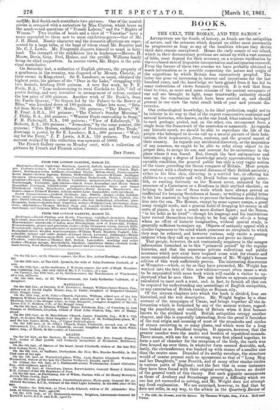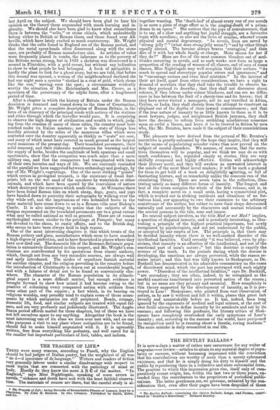BOOKS.
1HE CELT, thth ROMAN, AND THE SAXON.* ANTIQUITIES are the fossils of history, as fossils are the antiquities of nature, and the sciences which depend on either must necessarily be progressive as long as any of the localities whence they derive their data remain unexplored. Hence the early annals of our island, which in their documentary portions are mixed up with a vast amount of fable, must depend for their accuracy on a copious verification by the combined aids of linguistic interpretation and antiquarian research. From the former of these two sources we have probably obtained as much information as is possible respecting the nature and origin of the migrations by which Britain was successively peopled. The latter has gone on increasing in interest anti importance for the last hundred years, and the knowledge we have gained from it has led to many corrections of views formerly received. It is well that from time to time, as more and more remains of the ancient occupants of our soil are brought to light, some trustworthy au.thority should sum up the conclusions which have been arrived at, and should present in one view the total result both of past and present dis- coveries.
Our archreological knowledge, in its ideal perfection, ought not to be inferior in its way to that of the expert comparative anatomist and natural historian, who knows, on the one hand, what animals belonged to each geologic period, and, on the other, can reconstruct from a single bone the framework of the mastodon or mammoth. As regards any historic epoch, we should be able to reproduce the life of the people who belonged to it—to call up a menial picture of their habi- tations, their implements dress, customs, and the general aspect of their country. As regard's any accidental discovery, or the inspection of any museum, we ought to be able to refer every object to its proper date, to assign its use, and account for its occurrence in the place where it was found. But, though the best antiquarians and historians enjoy a degree of knowledge nearly approximating to this enviable condition, the general public has only a very vague notion of the times preceding the Saxon conquest of Britain. Most people are content with a shadowy mental diorama of their British ancestor; either in his blue skin, shivering in a wattled hut, or offering his
children to a venerable and wily Druid before some gigantic mono- lith, or rushing furiously on the Roman spear, animated by the
presence of a Caract,acus or a Boadicea in their scythed chariots; or helping to build one of those walls which have always proved so ineffectual for keeping Scotchmen at home; or writing a pitiful letter to his late masters to beg them to prevent the barbarians from driving him into the sea. The Roman, except by some square camps, a great many straight roads, and a general habit of dropping his money in all sorts of places, is not a much more distinct figure ; and the Saxon, "in his habit as he lived"—though his e and his institutions have rooted themselves too deeply to be lostof—is a being whom no effort of historic imagination, without special study, is generally sufficient to conjure up. Objects of antiquity appeal with a similar vagueness to the mind which possesses no receptacle to which they may be referred, and however curious, only excite a passing interest when they call up no association and prove no theory. That people, however, do not contentedly acquiesce in the meagre information furnished as to this "primeval period" by the regular histories, and that the numerous private collections and public museums which now exist have inspired some wish for`clearer and more connected information, the acceptance of Mr. Wright's former edition of this work sufficiently proves. The interesting discoveries at Wroxeter—which, as far as they have proceeded, Mr. Wright has worked into the text of this new edition—must often cause a wish to be acquainted with some book which will enable a visitor to un- derstand what he sees there. The one before us appears eminently calculated to meet such a want, and, in fact, to furnish all that can be required for understanding any assemblage of English antiquities, or any excavation of British tumulus or Roman city. Of the sixteen chapters into which the book is divided, four are historical, and the rest descriptive. Mr. Wright begins by a clear account of the campaigns of Ctesar, and brings together all the in- formation which is furnished by any of the ancient writers, regard- ing the population and condition of Britain when it first became known to the civilized world. British antiquities occupy another chapter, and this is especially interesting, from the proof it furnishes of the real origin and meaning of most of the cromlechs and circles of stones occurring in so many places, and which were for a long time looked on as Druidical temples. It appears, however, that the greater number were the nuclei and borders of sepulchral mounds. Three stones, with one for a covering, were first placed together, to form a sort of chamber for the reception of the body, the earth was then heaped up over them, in whatever form seemed desirable, and, lastly, the circumference was banked up with stones of a smaller size
than the centre ones. Denuded of its earthy envelope, the stracture would of course present such an appearance as that of "Long .Meg and her Daughters," near Penrith, and of many other similar circles in various parts of England; and the fact that in some instances they have been found with their original coverings, leaves no doubt of the general truth of this theory. But such gigantic monuments 38 those of Avebnry and Stonehenge present a difficulty which no one has yet succeeded in solving, and Mr. Wright does not attempt any fresh explanation. We are surprised, however, to find that he does not refer, in any way, to the article in the Quarterly Review of • The Celt, the Roman, and the Saxon. By Thomas Wright, Esq., F.S.A. Hall and Virtue.
last April on the subject. We should have been glad to hear his opinion on the theory there expounded with much learning and in- genuity. We should also have been glad to know what resemblance acre is between the " celts," or stone chisels, which undoubtedly belong either to British or Roman times, and those found near Ab- beville, which have lately excited so much controversy. Mr. Wright
thinks that the celts found in England are of the Roman period, and that the metal spear-heads often discovered along with the stone ones, are probably of Roman manufacture also. As articles of value
were frequently placed in tombs, the inference as to the poverty of the Britons seems strong, but in 1833 a skeleton was discovered in a mound in Flintshire, with a gold corset, but without any indication to show to what people he had belonged. A book of antiquities is hardly the place to look for a ghost story, but we are told, that before this mound was opened, a woman of the neighbourhood declared she had one night seen a spectre "clothed in a coat of gold, which shone like the sun," 'moving over the spot; a circumstance evidently worthy the attention of Dr. Reichenbach and Mrs. Crowe, as a specimen of the persistency of the odylic force, after a lengthened period of time.
After a chapter in which the history of Britain under the Roman dominion is resumed and traced down to the time of Constantine, Mr. Wright gives a complete description of Roman Britain, in the form of an itinerary of the principal roads with notices of the stations and cities through which the traveller would pass. It is surprising to observe the high degree of civilization ani wealth to which, judg- ing from the remains of many of these cities, the country must have reached under its Italian masters; nor is this state of things less forcibly attested by the 'relics of the numerous villas which were scattered over the country apparently as thickly as "seats" are now, and many of which must have covered as much ground as the largest rural mansions of the present day. Their tessdated pavements, their solid masonry, and their elaborate contrivances for warming and for the supply of baths, besides the multitude of both spacious and small apartments, show that the occupation was much more than a mere military one, and that the conquerors had transplanted with them all their own luxuries and ways of life. We are curiously reminded of the parallel we have suggested between archieology and geology, by one of Mr. Wright's enc.-ravings. One of the most striking "points" which occurs in geological research, is the existence of fossil foot- prints left on the wet sand of the sea-shore by waterbirds or other animals, and which have been spared by the convulsion of nature which destroyed the creatures which made them. At Wroxeter there have been found Roman tiles on which sheep, dogs, goats, and pigs have handed down to posterity their autographs by walking over the day while soft, and the impressions of two hobnailed boots in the same material have come down to us in a Roman villa near Bishop's Castle. It is also interesting to notice that the subjects of the designs represented on the tesselated pavements are to a great extent what may be called national as well as general. There are of course mythological scenes similar to the paintings at Pompeii; but many are devoted to the chase, to rustic affairs, and to the British dog, who seems to have been always held in high repute.
One of the most interesting chapters is that which treats of the Roman pottery and glass, manufactures which seem to have reached a high degree of perfection, and to have flourished in places where they have now died out. The domestic life of the Romano-Britannic popu- lation is extensively 'illustrated in this respect, and Mr. Wright's con- clusions are corroborated by his quotations from classic authors, which, though not from any very recondite sources, are always well and aptly introduced. The modes of sepulture furnish material for another chapter, and the religion prevailing in the country before the introduction of Christianity is drawn out at considerable length, and with a fulness of detail not to be found so conveniently else- where. The character of the Roman population in its ethnolo- gical aspect is a more difficult matter, but enough evidence is brought forward to show how mixed it had become owing to the practice of colonizing every conquered nation with soldiers from seine other part of the empire ; a fact which, in its bearing on religious worship, may possibly tend to explain some of those monu- ments by which antiquaries are still perplexed. Roads, co'
domestic life, food, and similar subjects are treated with equal ful- ness, and are very profusely and judiciously illustrated. The Anglo- Saxon period affords matter for three chapters, but of these we have not left ourselves space to say anything. Altogether the book is the most interesting one of its class we have ever met with, and, no one who purposes a visit to any place where antiquities are to be found, should fail to make himself acquainted with it. It is agreeably written, free from everything like pedantry, and well cared for in the smaller but important particulars of lists, tables, and indices.































 Previous page
Previous page